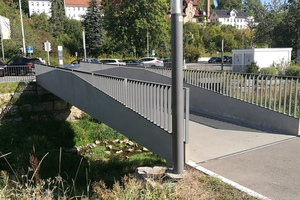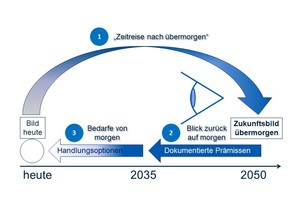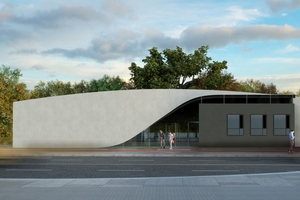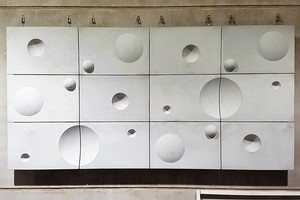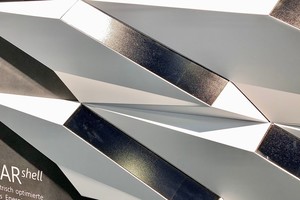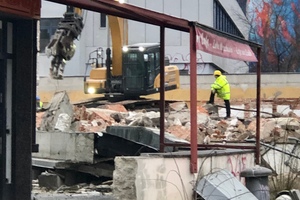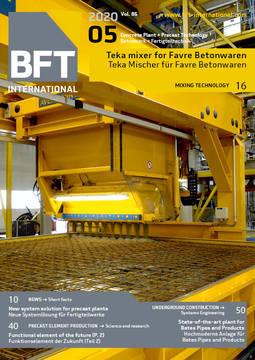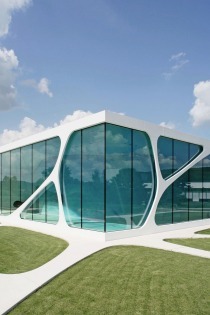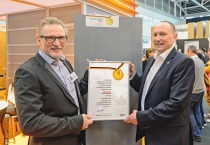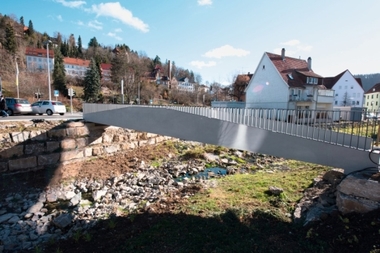Functional element instead of “pure”
slab – precast elements with inner life (2)
The decades of change have begun: in climate, nutrition, health, digitation, sustainability, migration etc. But profound changes also give rise to many questions. In this second part of the contribution, Thomas Strobel, the pilot into the future, focuses on precast element production: further task and innovation areas.
In the first part of this contribution (BFT 4/2020, pp. 52) we have seen that major global topical trends are acting with full force, with changes taking place at an increasingly rapid pace – also in the precast concrete industry. With the examples of nutrition of the future and serial prefabrication in factories (including bridges), we likewise named the first task and innovation areas to which the users of tomorrow will look. The two following examples – concerning new construction materials and their functional integration into building elements – are meant to encourage early searching for market potentials and new business opportunities.
1 New materials
We have seen for textiles that, suddenly, the technical textile industry “marries” IT and electronics to develop smart textiles (intelligent textures), a new family of materials. With textile intelligence, construction materials manufacturers now also have the opportunity to permanently monitor the characteristics: for example, of concrete elements or masonry, by means of integrated interior textile sensors. To whom now, to remain with the same metaphor, will the precast sector “get married” in the near future? Technology experts, especially from such fields as climate and lighting technology, should sit up and take notice – as well as specialists who know about sensor measurement and data recording, as well as energy generation and storage.
Yesterday’s solutions will meet the requirements of tomorrow only to a certain extent. Those who want to shape the future must think ahead and combine practical knowledge and a good understanding of trends – methodically, and best of all supported by an experienced expert in the context of previewing the future and developing strategy.
For future-oriented innovations in all aspects of building materials for lifecycle management – ideally, with a long service life, great durability and full recyclability – new materials or hybrids are generally required: i.e., a practical combination for high-performance materials. The new materials should be in line with the general trend of function integration (e.g., self-repairing fiber reinforcement structures, wallpaper that changes colors and heating concrete elements). In addition, if possible, the materials should be flexible and intelligent – and perhaps also situationally exchangeable.
2 Maps of the future as navigational instruments
Fast growth of knowledge has hastened developments in technologies and innovations, and more individual customer requirements increase the complexity that companies must master. But reacting to changes is often no longer sufficient, and anticipatory driving will therefore become a necessity for sustained corporate success and satisfied staff.
The objective of working with future scenarios is therefore never to describe a scenario that later happens in exactly that way. This is the reason why I, as pilot into the future, prefer to work with maps of the future in the form of mind maps. In these maps, known and feasible trends are linked to form a holistic view of a possible future. In this way, it can be logically reconstructed and analyzed as to which trends mutually strengthen themselves, and which hinder or even exclude each other. In this way we will ultimately arrive at completely new business ideas, an idea of the requirements of the customers of tomorrow and the development of new and attractive markets of the future.
Who then should engage in systematic future work? Generally speaking, the target groups are primarily organizations that today want to be part of shaping the future in a considered manner, instead of being driven by an uncomfortable present. In particular, these are people in responsible positions – e.g., chief executives of organizations, entrepreneurs and political decision-makers in municipalities and federal states – who are prepared to develop future solutions and concepts with a 360°-view.
Three developments in that direction come from the German federal states of Saxony, North-Rhine/Westphalia and/or Berlin/Brandenburg: textiles, recycling and geopolymer concrete.
2.1 Textile concrete
The original German contribution to sustainable and lighter concrete began 25 years ago at TU Dresden and continued with research work at RWTH Aachen. The basic innovation – which until now has not gone further than a prototype state and/or reference buildings such as footbridges with individual approval (by the DIBt) – was awarded the Future Prize – the German Federal President’s Award for Innovation in Science and Technology. In the meantime, several players have begun to develop products and objects for individual applications for concrete with composite fiber plastics instead of corrosion-prone structural steel.
2.2 Carbon concrete
Carbon concrete for a first prototype: nomen est omen. On a street fittingly named, Einsteinstrasse in Dresden, architectural history is being written. There, as “Ergebnishaus” – the C³ technology demonstration house CUBE of the C³ carbon concrete cluster – a federally funded joint research project of industry and science, was formed with the objective of making this new construction material fit for serial utilization. Accordingly, the world’s first building made of carbon concrete is being erected. Following prototype applications, including rehabilitation of buildings and bridges, the Cube will now be built in the near future – a building with a graceful, multiply-curved concrete shell roof. The following is planned on a site of 220 m²: laboratory and presentation rooms for all aspects of the general topic of textile concrete, which, at the same time, is meant as a start for a paradigm shift in building. The structural elements and connections developed for this are ready for the market. With a view to economic efficiency, application is taking place for the first time of specific cost models, quality standards, material parameters as well as computation and design processes.
The world’s first double-curved facade: the decorative exterior element with textile reinforcement, comes from the German state of North-Rhine/Westphalia and bears the name CurveTex. The new lightweight design facade, with a thickness of only three centimeters and with a weight of only 80 instead of the usual 270 kg, increases design freedom and saves up to 80 % in concrete and cement. With a drapeable reinforcing textile as its core, it affords architects greater design variety.
In terms of extrapolation (i.e., experienced based) the construction industry is in robust condition and is future-fit. But in retropolation (looking back from a more distant future to a nearer future), the industry is highly vulnerable. Successful continuing as before becomes more improbable than revolutionary disruptions.
2.3 RC and geopolymer concrete
At the recent bautec trade show, the company Beton und Naturstein Babelsberg GmbH (BNB) exhibited demonstration products made of certified recycling concrete (RC) and geopolymer concrete (G-concrete) – both with improved greenhouse gas balance. With RC concrete, the primary material for roadways, foundations and floor slabs, is given a second chance in the form of high-quality design products. Alone in Berlin, five million tons of construction rubble are generated yearly, one-fifth of that concrete. In collaboration with TU Berlin, geopolymer concrete, virtually still warm from the laboratory, is used here to good advantage for the same product lines. This G-concrete – which is lime-free and is therefore low in CO2 – follows in the tradition of antique builders and especially of durable Roman concrete. However, today, such substances as waterglass and aluminum silicate replace the materials used in the past as alternative binders, e.g., kaolin clay and volcano ash.
What does the 360°-perspective say? A development already implemented years ago by a university in Leipzig offers additional utilization value beyond climate control: a concrete wall with textile surface heating. Featuring integrated tubular structures, more solid building elements could simultaneously function as heat and cold storage systems. Optical fibers integrated into the concrete could, in addition, provide variable light colors and dimmable luminosity achieved with luminous wall and ceiling elements.
Another valuable pointer into the future is the service life of buildings. Seen in perspective, a useful life of fifty years, as currently standard, is short-sighted. With the availability of non-corroding construction materials and modular construction methods, we consequently face the necessity to double or even quadruple average building service life. This calls for sustainable concepts with further feasibility of multiple utilization. The buildings of tomorrow, moreover, will of necessity feature integrated energy generation and storage concepts, including rainwater management and multiple use of graywater. Photovoltaic facade and shading elements are first steps into these directions; cisterns as heat storage units represent another. Optimization of materials must in future be adapted to their intended use: extreme durability for buildings and building elements with long service life, to especially include environmental and recycling friendliness for applications with shorter lifetimes.
3 Smart precast elements and function integration
What are the potentials of precast elements in the smart buildings of the future? It is apparent that smart basic functions such as central locking systems and automated ventilation will require servos and sensors. In the future it will be possible to integrate into precast elements the power and data lines consequently needed for control functions: e.g., for panel heaters on the inside and solar heat collectors on outside surfaces. And the production processes for precast elements, which already today take place independently of the weather, best satisfy prerequisites for delivering the building elements of tomorrow with the planned functionality and intelligence to the construction site.
What does the 360°-perspective say? The pure concrete slab is a thing of yesterday. Function integration is a prerequisite for everything later to be automated and sustainably controlled in a building. The smartest, most sustainable building in the world, “The Edge,” which produces more energy than it consumes, gives us a taste of things to come. It was built in Amsterdam and provides room for flexibility at a modern workplace. This smart building assigns workplaces, the staff control their work environment individually by app, and individual comfort helps save electricity. Intelligent facility management in the form of 30,000 sensors throughout the building bring the Internet of Things (IoT) to the workplace.
When solar cells integrated in the glazing of facades are intended to deliver electricity in the future, this must be considered already in planning and production: both for the orientation of the surfaces and for the wiring of the loadbearing concrete structure. From the very outset, it will be essential to integrate sensors and servos in intelligent components as solutions in building modules. This will enable functions such as self-closing windows during rain and strong winds, as well as temperature equalization in the building by automatically opening and closing doors.
We have sketched out here only a few factors. Maps of the future with a view to the future of structural concrete elements would also be required to take into consideration influencing criteria such as the following: ongoing materials innovation with a view to regenerative raw materials, bionic design principles, update-capable buildings by combinations of especially durable loadbearing structures with exchangeable modules – which would be designed in keeping with the need for utilization and current technology – as well as new applications of function integration such as ice-free footpaths, air purification, energy harvesting, underground farming and building autarky.

